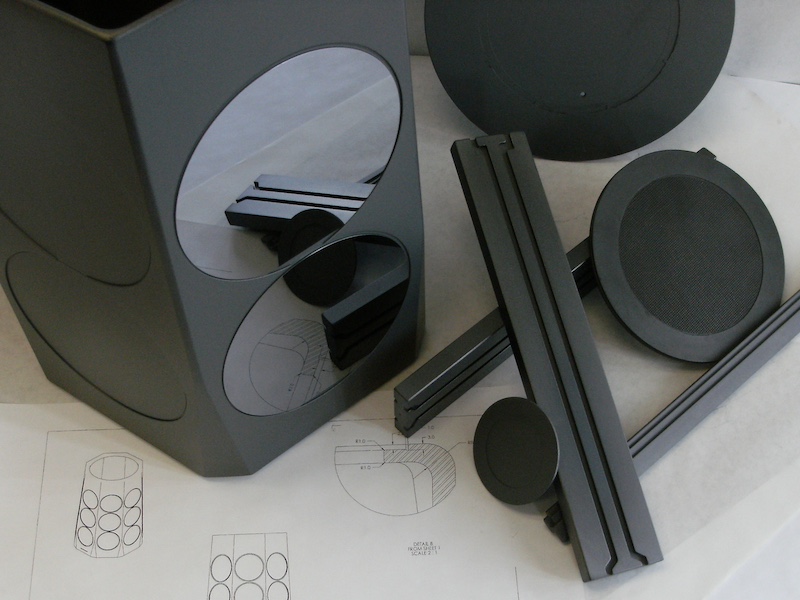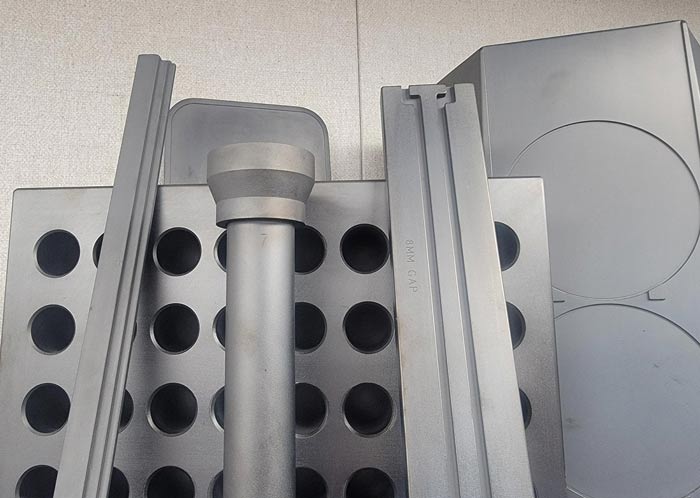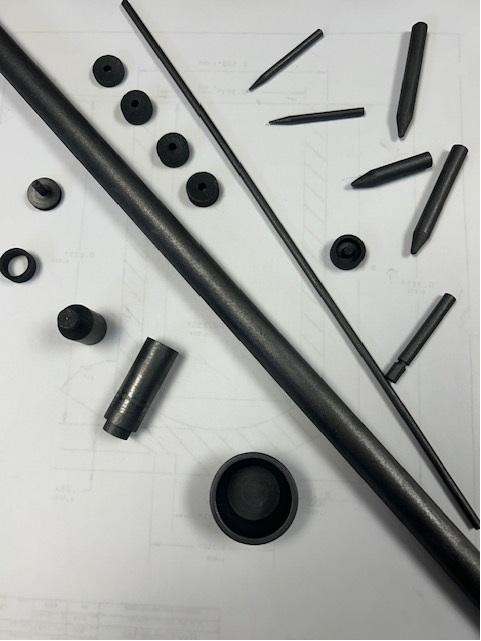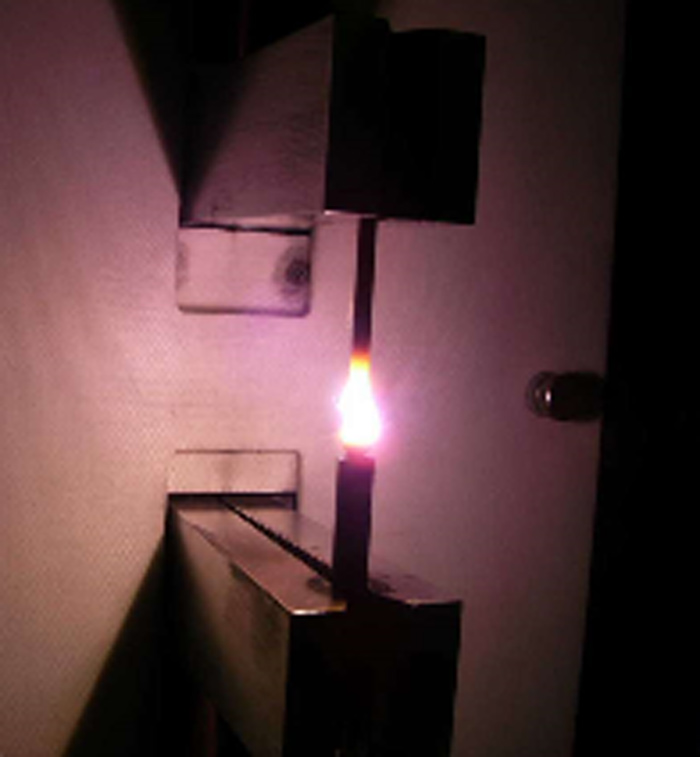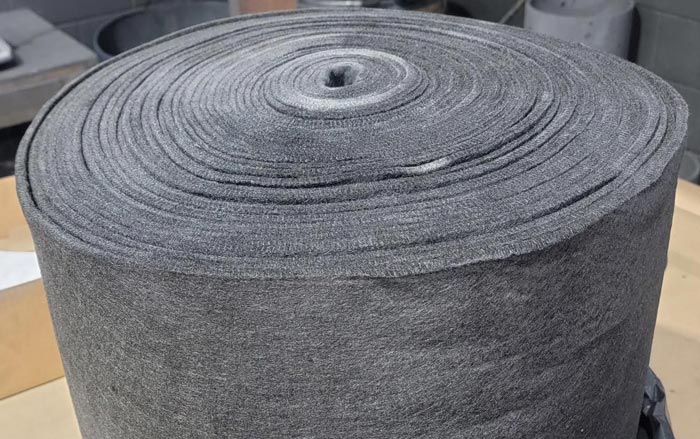Our Carbon Solutions Fuel Tomorrow’s Innovations
We’ve been a global supplier of Carbon & Graphite Products & Services since the 1970s. At Bay Carbon Inc, we specialize in providing high-quality Carbon & Graphite solutions to meet the diverse needs of various industries. From custom machined graphite components to advanced thermal management materials, we offer a range of expert, innovative services & harness the unique properties of graphite to serve our customers. Based in Bay City, MI, we serve clients worldwide, & we’re dedicated to making your experience great with quick service & high-quality products and services.
What We Do
For over 40 years, our experts have produced high-purity, molded & iso-molded graphite susceptors for CVD processes. Using our proprietary purification technology & DC Arc optical emission spectroscopy, we purify & test graphite to ensure it meets appropriate purity levels for semiconductor applications. We machine & supply over 30 different grades of graphite, including extruded, molded, isostatic molded, and porous materials.
Our Products & Services
Graphite Materials
Natural graphite is known for its excellent conductivity of electricity and heat, its lubricating properties, and its resistance to heat and chemical reactions. It is used in a wide range of industries, including energy storage (batteries), steelmaking, lubricants, refractory materials, brake pads, and as a precursor for producing synthetic diamonds and other carbon-based products.
Synthetic graphite is a man-made form of carbon that is produced through a process of high-temperature treatment of carbon-rich materials, such as petroleum coke, coal tar pitch, or other carbon precursors. Unlike natural graphite, which is mined from the earth, synthetic graphite is created in a controlled environment to achieve specific properties, including high purity and consistent structure.
Analytical Graphite
High Purity Graphite
Molded & Iso-Molded Graphite
This is a synthetic form of graphite engineered with high accuracy & consistency in mind, making it useful for applications where tight tolerances & exacting specifications are necessary for optimal performance & reliability.
Isostatic Molded Graphite
Isostatic molded graphite, also known as isostatically pressed graphite, is a type of synthetic graphite that is manufactured using a specific process called isostatic pressing. This process involves applying equal pressure to a mixture of fine carbon particles and binder in all directions, resulting in a highly uniform and dense material. The uniformity of the material makes it an ideal choice for applications that require extremely tight tolerance machining, guaranteeing precision and dependability in high-performance settings.
Phenolic Resin Impregnated Graphite
Graphite Foil
We offer sheets and rolls of this material, which is made from natural graphite flakes & can be used for sealing, heat spreading, pressure equalizing, & more.
- 0.5mm (roll and sheet)
- 0.8mm (roll and sheet)
- 1.0mm (sheet),
- 1.5mm (sheet)
Graphite Powder
- Natural Flake: This processed natural graphite can be used in a variety of industrial applications such as lubricants, batteries, & coatings.
- Synthetic: This man-made material is typically more than 99% carbon & can be used in a variety of industrial settings such as corrosion products, conductive fillers, & rubber/plastic compounds.
We also offer particle size analysis of Carbon & Graphite Powders.
Precision Machining
At Bay Carbon, our state-of-the-art machining facility specializes in precision machining of carbon and graphite materials, rigid insulation board, carbon-carbon, carbon composites, and graph foil. Our expert machine shop team is dedicated to providing exceptional design support for both new and existing products. With a commitment to precision and innovation, we work closely with our customers to understand their specific needs and turn their ideas into reality. Our experienced engineers and machinists use advanced technologies and industry best practices to deliver high-quality components that meet the strictest standards across all the industries we serve. Whether you’re developing a new design or refining an existing one, we’re dedicated to ensuring your success at every stage.
Our approach ensures quick turnaround times, giving your company a competitive edge in bringing products to market. We’ve optimized our machining capabilities to meet the diverse requirements of all our customers, offering turning capabilities for parts ranging from micro-sized components up to 40 inches in diameter and up to 80 inches in length. Our milling department can handle components ranging from micro-sized parts to those as large as 40 by 80 inches, with the flexibility to accommodate even larger sizes depending on project needs. This versatility enables us to manage a wide range of projects, always maintaining the highest standards of precision and quality.
Laboratory Graphite
Laboratory graphite refers to high-purity graphite specifically designed for use in laboratory settings, particularly in scientific research, analytical chemistry, and materials science. This form of graphite is characterized by its uniformity, consistency, and low levels of impurities, making it suitable for a variety of precise applications.
We offer a range of laboratory graphite products, which include DC/Arc electrodes tailored for analyzing high purity copper & modern materials. The grades of graphite used for the Arc electrodes are chosen for uniform conductivity & structure. Our electrodes are produced according to ASTM E 130 standards. Additionally, our low & high purity graphite products are suitable for fusions & melting high purity copper.
- Available in standard sizes from 10ml-40ml
- Custom sizing upon request
Read More:
- SP-1 high purity graphite powder line is used to create conductive samples for analysis
- SP-2 high purity graphite powder line is used as a buffer for volatile samples
Graphite Purification
Bay Carbon employs a state-of-the-art proprietary process featuring Chemical Vapor Purification (CVP), a highly specialized method that enhances the purity and quality of graphite for a wide range of applications. CVP is one of the most effective purification techniques available, yielding exceptionally clean, high-performance graphite suited for even the most demanding industries.
To meet diverse customer requirements, we offer three distinct levels of purification, each tailored to meet varying specifications and industry standards. These options are ideal for sectors with strict purity demands, including the semiconductor and other high-tech industries, where consistent, high-quality graphite products are essential for operational efficiency and product reliability.
Supporting this purification process is our own in-house laboratory, fully equipped to perform comprehensive testing and quality control throughout each stage of production. Our lab’s capabilities allow us to ensure precise adherence to specifications, offer quick turnaround times on testing, and provide the high level of quality assurance our customers depend on.
With this combination of advanced purification technology, versatile purification levels, and rigorous in-house testing, we’re committed to delivering superior graphite products that enhance our clients’ applications and set new standards in the industry.
High Purity: ≤ 20 ppm
CVP Purity:
- No more than 2 elements may be present & no single element may exceed 1 ppm
- Performed on an ATOMCOMP, which uses a strong electric current to analyze the materials. A Charge Injection Device (CID) then converts light into an electrical charge, manipulating it to capture & process visual information. The CID surrounds the electrode with inert gas to stabilize the arc & reduce cyanogens banding.
Semiconductor Purity: ≤ 5 ppm
- Uses a Glow-Discharge Mass Spectrometry (GDMS) & provides full periodic table coverage (except H)
- 7-10 business days for testing results
Spectrochemical Analysis Report
Spectrographic Electrodes & Supplies
Spectrographic electrodes are specialized graphite electrodes used primarily in spectrochemical analysis, where they help in detecting and analyzing elemental compositions in samples. These electrodes are commonly made of high-purity, low-ash carbon graphite to ensure they don’t contaminate samples and provide consistent and accurate results.
Key Characteristics
- High Purity: Typically made from ultra-pure graphite, which minimizes interference from impurities in spectrographic measurements.
- High Thermal Conductivity: Allows efficient heat dissipation, which is crucial during high-temperature applications.
- High Electrical Conductivity: Ensures steady current flow, allowing consistent excitation in spectrochemical analysis.
Uses
- Atomic Emission Spectroscopy (AES) Systems: These systems use spectrographic electrodes to excite samples so that the emitted light can be analyzed to determine elemental compositions. AES is widely used in metallurgy, environmental science, and chemical analysis.
- Inductively Coupled Plasma Optical Emission Spectroscopy (ICP-OES) Equipment: ICP-OES systems often use graphite electrodes for sample analysis, especially in high-purity testing environments. These systems excite atoms and ions in the sample, allowing precise analysis of a wide range of elements.
- Direct Current Arc Spectrometers: Arc spectrometers utilize high-purity graphite electrodes to create an arc discharge, which vaporizes the sample material, exciting it to emit light that can be analyzed for elemental content. These are frequently used for metals, alloys, and mineral samples.
- X-ray Fluorescence (XRF) Analyzers: While graphite electrodes are less commonly used directly in XRF, graphite is sometimes used as a backing material or in other components due to its purity and stability in high-energy environments.
- Glow Discharge Mass Spectrometry (GD-MS): This technique uses a glow discharge to vaporize samples, sometimes using graphite for electrode components due to its ability to sustain the plasma.
Graphite’s high-purity, thermal stability, and conductivity make it essential in these systems for consistent, non-contaminating performance.
DC Arc Direct Analysis
This technique has been used for decades for the direct analysis of various solid materials. Early instruments were eventually replaced by PMT-based simultaneous spectrometers, & later, CID-based DC Arc spectrometers, each with advantages & drawbacks.
Prodigy DC Arc
The Prodigy DC Arc stand is an upgrade from the original “Spex” design used in earlier DC Arcs, & features a user-friendly counter electrode that rotates out for easy sample electrode installation. It includes a current-stabilized power supply for improved stability & an optional Stallwood Jet to reduce CN (cyanide) band emissions when needed.
- Can directly analyze powders, wires & chips without the need to digest or dilute the sample.
- Full Spectrum Acquisition mode gives user the ability to capture a permanent data record of the full DC Arc spectrum for future reference.
- Gives user the ability to subtract spectra from one another.
Echelle Optical System
Benefits Of DC Arc Elemental Analysis
- Eliminates Sample Digestions
- Provides Low Limits of Detection
- Fast Qualitative & Semi-Quantitative Analysis
- Capture Full Spectrum & Perform
- Elemental Fingerprinting
Graphene
Graphene, a form of carbon, is one of the most studied 2-D electronic materials in research. While still early in development, performance milestones have been shown with graphene-based materials & devices across electronic, chemical, & mechanical product applications.
Read More:
If pursuing research in graphene materials, we can give precursor materials that can be adopted to meet the needs of the targeted application.
Coatings
Silicon Carbide Coating
Tantalum Carbide Coating
Pyrolytic Coating
Insulation Material & Other Carbon / Graphite Products
Insulation materials provide exceptional thermal resistance, making them ideal for applications where heat retention or protection is crucial. These materials effectively minimize heat transfer, providing energy efficiency & safeguarding against temperature fluctuations.
Flexible Felt Insulation
Flexible Felt Insulation is a high-performance thermal insulation material commonly used in applications that require both flexibility and efficient heat management. Made from carbon or graphite fibers, this felt insulation provides excellent thermal resistance, lightweight durability, and versatility, making it ideal for high-temperature environments where traditional rigid insulation cannot be used.
Key characteristics of Flexible Felt Insulation include:
- High-Temperature Resistance: Designed to withstand extreme temperatures, this insulation is often used in applications requiring thermal protection in temperatures exceeding 2000°C in inert or vacuum environments.
- Flexibility and Conformability: Unlike rigid insulation materials, flexible felt can easily adapt to complex shapes and contours, allowing for a snug fit around equipment, pipes, or irregular surfaces.
- Low Thermal Conductivity: The carbon or graphite composition provides low thermal conductivity, reducing heat loss and ensuring energy efficiency in high-temperature applications.
- Lightweight and Easy to Handle: This material is lightweight and easy to cut, shape, and install, which streamlines the installation process and minimizes additional weight on equipment.
Flexible Felt Insulation is commonly used in applications across industries like aerospace, semiconductor manufacturing, solar energy, and high-temperature furnace manufacturing. Its unique combination of flexibility, thermal resistance, and durability makes it a top choice for protecting equipment and processes from extreme heat.
Thickness
- 1/8”
- 1/4″
- 1/2″
Hard Felt Insulation
Carbon Cord
This braided material is made from carbonized polymer thread & can be used for edge reinforcement, connecting components, & more.
Expedited Deliveries
We offer expedited delivery options to ensure fast & efficient shipping of our products, meeting tight deadlines & minimizing downtime for our customers. You can count on prompt & reliable shipments to keep your projects running smoothly.
R&D Services
Our company is committed to research & development. We offer comprehensive R&D services to universities to drive innovation & create advanced carbon-based products that meet the needs of our clients & the evolving demands of the market.
Could you benefit from expert carbon solutions? Call us today at 989-686-8090 or contact us.
Bay Carbon Inc
Contact
Call: 989-686-8090
Business Hours
8:00 AM to 4:00 PM
Saturday & Sunday
Closed

